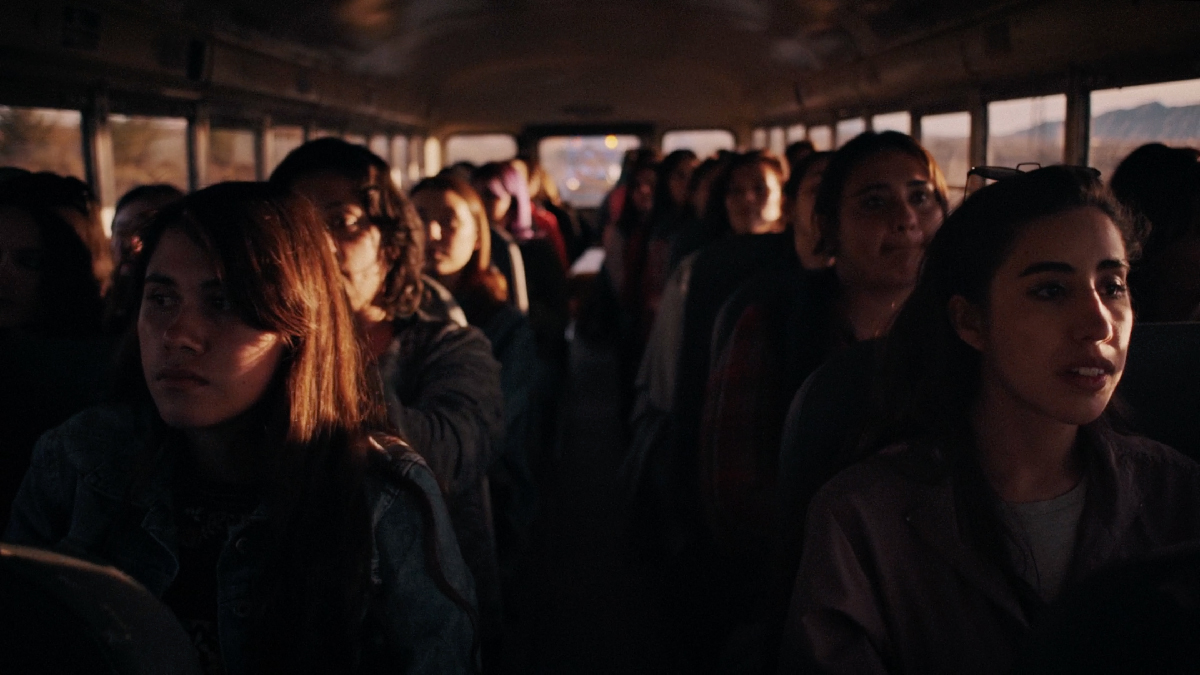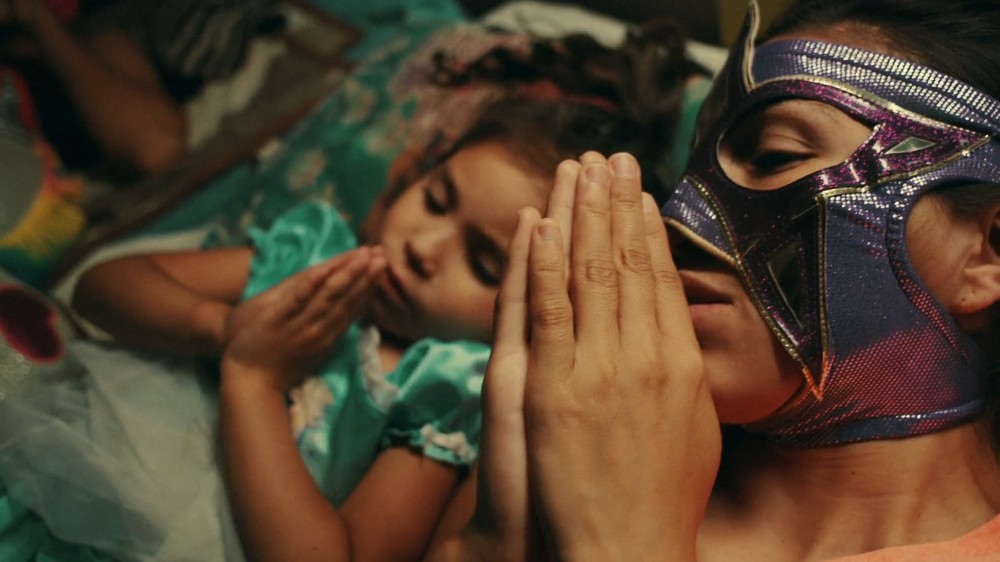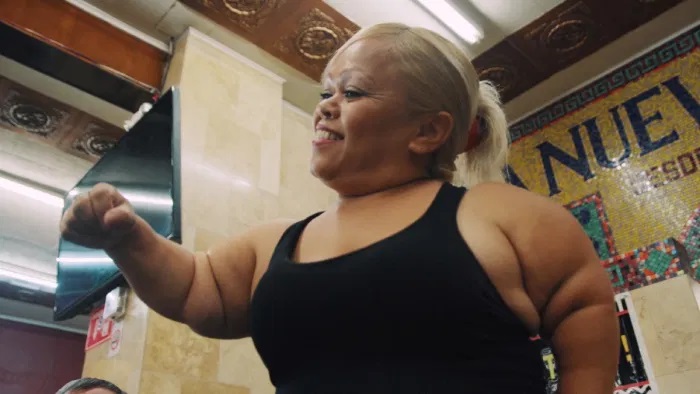There’s a bold statement made near the beginning of Luchadoras, a documentary directed by Paola Calvo and Patrick Jasim who, along with Phillip Kaminiak, produced the film through their Berlin-based Tumult Film company. The statement comes from one of the film’s main subjects, who labels Ciudad Juárez, Mexico, the film’s location, “the most dangerous city in the world.”
The city’s recent history arguably bears this description out. A 2019 USA Today article by Rick Jervis traces the extreme rise of embedded violent culture found in Juárez to the late 2000s, during a time when escalating wars between rival drug cartels created warzone conditions in the city. Jervis writes that the city became a place with “bodies strewn across downtown streets and where gang lords hung the beheaded corpses of rivals from highway overpasses.” The very same type of images were used for dramatic purposes in the fictional thriller Sicario (2015), which utilized Juárez as its setting.
Keep this in mind as you watch a documentary that’s ostensibly about female lucha libre wrestling, but is in fact concerned with more heady, socially-minded material. This isn’t a film that spends all of its time breaking down moves or match bookings, although those elements are certainly there; this is a film about women fighting both inside and outside of the ring for their dreams, their livelihood, and their own safety.
The opening of the film acquaints the viewer with the style that is to come. It’s beautifully shot, with lingering cinematography that gives it the feel of a dramatic film. There is limited narration, which never features on-the-nose descriptions of either what is happening on screen or purportedly inside the subjects’ minds, and nobody ever speaks directly to the camera or to an interviewer. In this way, the film leaves much of the construction of a storyline in the hands of the viewer, demanding they pay attention to details as they are offered. Nothing will be neatly spelled out.

A still from the opening scenes of Luchadoras. Photo courtesy of Tumult Film.
The opening sequence is not about wrestling. It’s about women on a bus, heading to work at an assembly factory. There are stories of women workers on buses being driven off route and assaulted or killed by the drivers. The buses continue to operate because that’s the pathway to work, which is needed to try and get away.
The filmmakers show a keen sense of pacing, as they move from the broad, cinematic strokes of the opening ten minutes into more focused, personal stories. It is a woman named Candy who spoke in the beginning of the film, labelling Juárez as the most dangerous city in the world, and it’s she who explains that the violence especially targets women. Candy works at a morgue for her living; we watch her polishing coffins and arranging services while she speaks to another co-worker about her family struggles.
Candy hasn’t seen or spoken to her daughters in months, as their father is blocking her attempts to contact them. He lives with them across the border in El Paso, Texas, and she doesn’t have the required documents to cross. She watches a video on her phone with one of her daughters singing a silly song, and asking when they’ll see her again. It’s heart-wrenching, and the scene comes just ten minutes into the film. To establish that kind of mood and emotion so quickly is a credit to the filmmakers.
Candy returns to that video again and again throughout the feature; it is one of the things that keeps her focused as she chases the goal of crossing the border to see the girls. It’s not a simple process to obtain her travel documents, with lengthy booking schedules and her modest income making it a challenge to put it all together.
All the while, she wrestles as Lady Candy, a maskless luchadora. In front of small crowds, she fights under the persona of a beloved, sometimes bloodied champion, cheered as she fights the good fight. When an opportunity presents itself to sign up for a fight with stipulations — putting her long hair on the line against an opponent’s mask — she weighs the consequences of the match not against her success or reputation in the ring, but against how it might help or hurt her chances at getting across the border.
The viewers next meet a young, masked woman. She wears the mask throughout the film: in the ring, in her home, and in her daughter’s bed putting her to sleep. This is Baby Star, who has wrestling blood in her family. We also meet her sister Little Star and we hear about her luchador father, Estrella Roja, through her uncle. Although the film doesn’t lay out her whole family tree, her uncle and cousin also fight in the ring.

A still of Baby Star and her daughter from Luchadoras. Photo courtesy of Tumult Film.
For Baby Star, her dream is to get back to Mexico City and pursue wrestling full-time in her life again, after stopping when she became pregnant. We watch her on TV with her sister, promoting fights on local talk shows, in a shop designing a new mask, and we see her in the ring fighting against devious men who seek to unmask and humiliate her. The wrestling scenes are told without much context in terms of the booking. They aren’t suggested as real fights, but they are filmed in a way that focuses on the battles that the characters endure.
We also meet Mini Sirenita, who, as her name suggests, is short in stature but taking her bumps like everyone else in the film. Through Sirenita, who shares Baby Star’s dreams of making a name for herself in Mexico City, we learn the most about the institutional violence against women in Juárez. She works at a factory, and her walk home, even though surrounded by a camera crew, is presented as a foreboding event, which she risks every day. She checks in with her mother and thanks God for making it home safely, which one presumes is also a daily ritual.
When Lady Candy, Baby Star, and another luchadora by the name of Miss Kath set up an outdoor photo shoot by some railway tracks, they’re admonished for “going to the slaughterhouse,” an area renowned for the abduction or disposal of women. Yet there they are, in full gear, taking photos of themselves in fighting poses.
They feel that they have pushed their luck as far as they can and leave when a car stops nearby. That’s enough to signal that their time on location is up.
In a very subtle but evocative scene, we see all three women in a training session. There are men in the ring with them, surely making the point that there are not uniformly gender-based divisions that the film is trying to exploit. Outside the building, a group of young woman wait to be invited in. Although the first impression might be that they are fans waiting to meet the luchadoras or to get a peek at their training session, the scene transitions into a self-defence class for these for women.
Later, a wrestling event in the film gives the opportunity for women to shout out their cries for equality, safety, and justice for those who received none of those. This is the point where the film’s message is at its clearest: wrestling is not the focus here at all. These are fighter women. That’s what a luchadora is.

A still of Mini Sirenita from Luchadoras. Photo courtesy of Tumult Film.
The points at which the stories of Candy, Baby Star, and Sirenita are wrapped up for the film are somewhat uneven, as in a documentary you can’t quite control the timelines and where the subjects’ lives are heading. Still, there’s enough of at least a suggestion for each woman in terms of achieving their goals laid out in the film, and substantially more of a finish for one of them.
The wrestling scenes in the film are shot with a touch of reverence, and there’s no false pretenses about trying to make these events bigger than they are, or the women to be bigger wrestling stars than they are. In this world of luchadoras, the most important question may be what Baby Star asks of her own daughter: “Do you want to be a fighter?”
When the young girl says yes by the end of the film, there’s a sense that a mother has done part of her job in preparing her daughter for a tough future. That’s as hopeful a coda as one could place on a film as open and honest as this one.
Luchadoras had its world premiere at the SXSW Film Festival in March of 2021. SlamWrestling.net will update this article with information about where to watch the film when it becomes available.
Luchadoras (2021)
| Directed By: | Paola Calvo, Patrick Jasim |
| Featuring: | Lady Candy, Baby Star, Mini Sirenita |
| Runtime: | 1 hour and 33 minutes. |
RELATED LINKS
Tumult Film’s official website
Luchadoras
Slam Wrestling’s Hollywood Headlock Rating Scale:
1: Unsafe Worker (Avoid!)
2: Pre-Show Performer
3: Mid-Card Material
4: Main Eventer
5: World Title Winner



